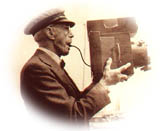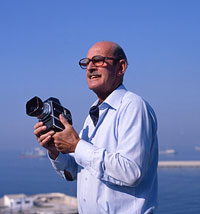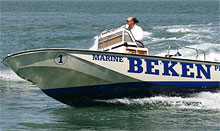Beken History

RAINBOW, 1898 No. 9153
Alfred Edward
Beken, originally from Canterbury in Kent, moved to the Isle of Wight
in 1888 with his son Frank and purchased an existing pharmacy situated
in the small port of Cowes, famous for its International Sailing Regatta.
The sight of yachts sailing past his bedroom window made such an impression
on Frank that he decided to capture these images on film.
After several attempts it was soon obvious that the cameras available
at the time were not suited to the rough seas encountered, so Frank designed
and had built a new style of camera. Instead of the usual canvas bellows,
he used two wooden box-frames. One enclosing a screw-thread focussing
system and shutter, with the other frame housing a viewfinder. It was
in fact a forerunner to the later twin-lens cameras although his was fired
by biting a rubber ball held between the teeth!

It was Frank's bedroom window that also provided the light source for
his 'daylight powered enlarger' which enabled him to make saleable prints
from his negatives.
The Beken Pharmacy sold these photographs alongside their medicines and
perfumes and undoubtedly due to Queen Victoria's Royal residence being
nearby at Osborne, it was recorded that five crowned heads of Europe visited
the Pharmacy premises at one time!

Keith Beken
Frank was joined by his son Keith in the 1930's. Keith had qualified as a chemist
and during WW II skippered an Air Sea Rescue launch based in Cowes. Keith
photographed the famous J-Class, started the colour photography in the
1950's and later took his cameras to various sailing regattas in the Mediterranean
and Caribbean.
Frank died in 1970 and it was decided that the pharmacy should be sold
and the photography side of the business should stand alone. Keith was
joined by his son Kenneth and a new company called 'Beken of Cowes' was
established
exclusively photographing afloat and selling the marine photographs that
have made the Beken name famous throughout the sailing scene.
The Beken of Cowes Marine Photography Gallery is now popular with yachtsmen
from all over the
World who come to see the classic historical photographs as well as the
colour images taken of today's racing and cruising craft. Those unable
to visit access the Beken website at www.beken.co.uk
Keith retired from photography afloat in the mid 1990's after taking the
famous photograph of the "Silk II" pitch-pole incident.
Keith died in February 2007, aged 92.

Keith Beken
Keith's son Kenneth joined "Beken of Cowes" to become the third photographer in line taking the photographs that have made the Beken name famous throughout the sailing scene. In over 45 years he has covered Worldwide gatherings such as Tall Ship Races, Offshore Powerboat Races, America's Cup Races, International Sailing Regattas, plus numerous Dinghy & Windsurfing events.
Photograph & Print History
Beken started their photography in 1888 when Alfred Edward Beken (1855-1915) came to Cowes & opened a pharmacy. It was his son Frank (1880-1970) who was so impressed by the classic yachts sailing off Cowes that he started the Beken Marine Photography Archive. In 1914 the ‘West’ collection of glass plates dating back to 1880 was purchased to add to his growing collection of negatives. By the 1930’s Frank’s son Keith (1914-2007) was busy photographing afloat and in 1970 Keith’s son Kenneth (b.1951) joined the Company. Each generation has earned the title “Fellow of the Royal Photographic Society” and the Company has held three Royal Warrants for excellence. More recently in 2001 staff colleague Peter Mumford became actively employed photographing afloat adding to the modern digital colour library.
Up to 1970 the photographs were signed Beken & Son by hand in white
ink. From 1970 when colour photography came to the fore, until the darkrooms
closed in 2008, all photographs were signed Beken of Cowes again by hand
with white ink.
Early 12” x 10” photographs dating from the turn of the last
century up until the 1930’s, have fetched £1,000 at London
auctions, more for larger or framed examples. These photographs were signed
Beken & Son, carried an embossing stamp, were titled by Frank Beken
himself and printed close to the date the actual photograph was originally
taken .
Later hand-printed Sepia-Brown enlargements, (ie 1945-1970) are estimated
at a value of £200 to £500. Should you be considering the
sale of any Beken & Son titled print, we would recommend you contact
a good auction house to get an appraisal. The bigger auction houses
in the UK usually hold regular local-to-you monthly valuations and advertise
their dates in local newspapers or on their websites.
In 2005 Beken changed to taking their photographs digitally. In 2008
with the advancement in the quality of digital printing came the move
to supply all prints digitally too, and after 120 years of service the
darkrooms were finally closed. Beken have a small range of Silver Gelatine
Photographs left which they sell from their Gallery in Cowes.
Virtually all the original glass plates & transparencies are intact
and are individually scanned & enhanced to create today’s
high quality prints which still receive a great deal of hands-on attention.
Today’s digital prints are now signed simply: Beken & it is
felt that these prints are every bit as good as those once produced
in their traditional darkrooms. Beken now produce top quality signed
& numbered Limited Edition archive Prints.
Please be advised that Beken images have been published as Books, Calendars,
Cards & Posters, which when framed can look like a real photograph
but are not designed to last when exposed to strong light.
Also, should you own a Beken print or photograph, the Copyright remains
with Beken and reproduction, replication & copying – even
in paintings - is only permitted under licence.
